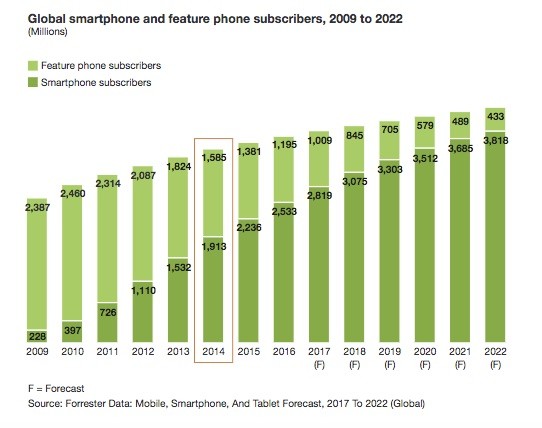 Mobile phones are expected to be in the hands of 66% of the world’s population by 2022, with mobile device usage slated to reach 5.5bn users by then.
Mobile phones are expected to be in the hands of 66% of the world’s population by 2022, with mobile device usage slated to reach 5.5bn users by then.
That is almost double the total number of users (2.8bn) in 2008, according to a report by Forrester, with up to 3.8bn new users predicted during the next five years, crossing the 50% mark for smartphone use by population in 2017.
The report noted that smartphone use is expected to increase particularly in Asia and Latin America, which remain major growth areas for mobile subscribers.
While smartphone subscribers surpassed feature phone subscribers in 2014, nearly 1.2bn people still used feature phones as their primary phone in 2016, which makes feature phones still attractive, the report noted.
“Nokia relaunched the iconic feature phone 3310 to address this market in February 2016, targeting emerging markets like India,” according to Forrester analysis’ report. Meanwhile, “India remains the fastest-growing market for smartphone subscribers, followed by Vietnam and Nigeria. We expect that by 2020 around 433m subscribers will still be using feature phones as their primary phone.”
 The Forrester report looked at 9,020 respondents between the ages of 18 and 97 throughout much of Asia and Australia as well as accessing more than 40 annual forecasts across Europe, Asia Pacific and Latin America.
The Forrester report looked at 9,020 respondents between the ages of 18 and 97 throughout much of Asia and Australia as well as accessing more than 40 annual forecasts across Europe, Asia Pacific and Latin America.
Global mobile, smartphone and tablet forecasts include nearly 94% of smartphone owners who use Android or iOS. Android is expected to capture 73% of the market share (with more than 1.8bn users) in 2017, followed by Apple (21%) and Windows (4%), the report suggested.
“Microsoft is working on a new phone based on Windows, but it has not set a launch date. As a result, the Forrester analysts noted that “powered by the low-cost smartphone manufacturers in China, Android will retain its dominance in mobile operating systems.”
Large-screen smartphones are contributing to the decline in tablet users: The total tablet installed base will decline at a compound annual growth rate of 1.1% from 2017 to 2022, dropping from 615m in 2016 to 579m in 2022. However, the Forrester report suggests that business-owned tablets will grow at a compound annual growth rate of 6.9% by 2022, powered by the adoption of the iPad Pro and 2-in-1 devices.
Yet, the overall installed base for business-owned tablets will remain low, from 100m to 155m in 2022, according to the report.
Source: The Drum

You must be logged in to post a comment Login